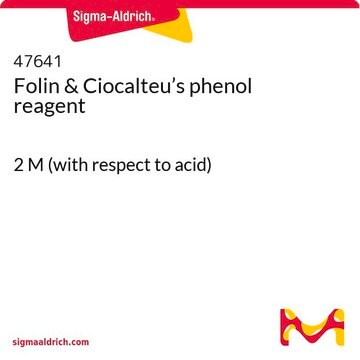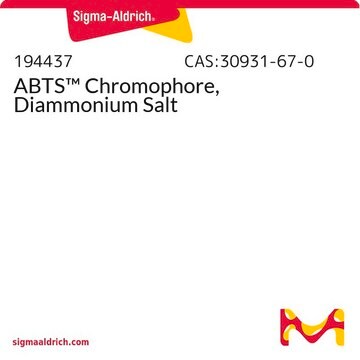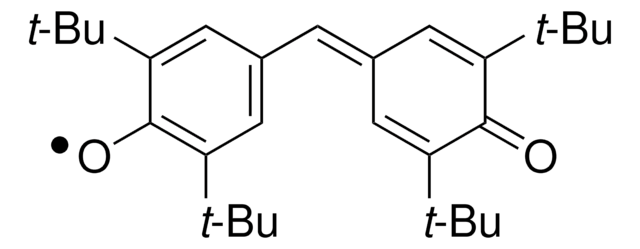300267
DPPH, Free Radical
≥90% (elemental analysis), solid, hydrogen radical scavenger, Calbiochem®
Synonym(s):
DPPH, Free Radical
About This Item
Recommended Products
product name
DPPH, Free Radical, DPPH, Free Radical, CAS 1898-66-4, is a cell-permeable, stable free radical that acts as a hydrogen radical scavenger.
Quality Level
Assay
≥90% (elemental analysis)
form
solid
manufacturer/tradename
Calbiochem®
storage condition
OK to freeze
protect from light
color
black
solubility
DMF: 10 mg/mL
ethanol: 5 mg/mL
shipped in
ambient
storage temp.
−20°C
InChI
1S/C18H13N5O6/c24-21(25)15-11-16(22(26)27)18(17(12-15)23(28)29)19-20(13-7-3-1-4-8-13)14-9-5-2-6-10-14/h1-12,19H
InChI key
WCBPJVKVIMMEQC-UHFFFAOYSA-N
General description
Biochem/physiol Actions
Hydrogen radical scavenger
Warning
Reconstitution
Other Notes
Karki, S.B., et al. 2000. J. Pharm. Sci.89, 1518.
Ancerewicz, J., et al. 1998. Free Radic. Biol. Med.25, 113.
Dinis, T.C., et al. 1994. Arch. Biochem. Biophys.315, 161.
Legal Information
Signal Word
Danger
Hazard Statements
Precautionary Statements
Hazard Classifications
Acute Tox. 4 Dermal - Acute Tox. 4 Inhalation - Acute Tox. 4 Oral - Eye Irrit. 2 - Resp. Sens. 1 - Self-react. C - Skin Irrit. 2 - Skin Sens. 1
Storage Class Code
4.1A - Other explosive hazardous materials
WGK
WGK 1
Flash Point(F)
Not applicable
Flash Point(C)
Not applicable
Regulatory Listings
Regulatory Listings are mainly provided for chemical products. Only limited information can be provided here for non-chemical products. No entry means none of the components are listed. It is the user’s obligation to ensure the safe and legal use of the product.
FSL
Group 5: Self-reactive substances
Nitro compounds
Hazardous rank I
1st self-reactive materials
JAN Code
300267-MG:
300267-50MG:
US2300267-50MG:
Certificates of Analysis (COA)
Search for Certificates of Analysis (COA) by entering the products Lot/Batch Number. Lot and Batch Numbers can be found on a product’s label following the words ‘Lot’ or ‘Batch’.
Already Own This Product?
Find documentation for the products that you have recently purchased in the Document Library.
Customers Also Viewed
Our team of scientists has experience in all areas of research including Life Science, Material Science, Chemical Synthesis, Chromatography, Analytical and many others.
Contact Technical Service














